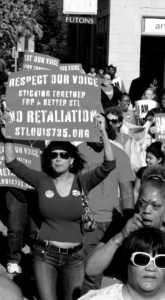
The Scene staff
How did we get a minimum wage anyway? In the 1930s, during the Great Depression, President Franklin D. Roosevelt enacted a series of programs called the New Deal that focused on bettering the lives of American workers.
In 1935, the New Deal established a maximum number of hours one person could work, as well as a minimum wage. A person could work no more than 44 hours per week and make no less than a quarter an hour, the equivalent of $4.38 today.
Now $4.38 seems like nothing, right? You’d be offended if you were offered $4.38 for an hour of work.
The highest minimum wage adjusted for inflation was in 1968, when it was $1.60, the equivalent of $11.05 today, according to usinflationcalculator.com. Instead, the national minimum wage is $7.25. Here in Missouri, it’s a bit higher at $7.65, but that 40-cent difference doesn’t do much.
The purpose of a minimum wage was to establish fair pay so workers could afford to provide for themselves and their families. Today’s minimum wage equals about $15,000 a year, not adjusted for taxes and other deductions. To a college student, $15,000 may seem like a lot, but realistically, minimum-wage workers only get 25-30 hours a week. Before taxes, that’s not even $12,000 a year.

In St. Louis, a cheap apartment can rent for $350 a month, but that may be in a rough neighborhood. The $350 comes out to $4,200 a year, more than a third of your income right there. Rent sometimes covers natural gas, electricity, water, sewage and trash pickup. I’ve personally never lived anywhere that didn’t cover sewage, water and trash pickup. Electricity and gas are likely to run $50 a month, or $600 a year, and factor in even more for heating or air conditioning.
Transportation is typically a higher cost. If you are the economical with your expenses and either walk or use public transit, you’re set back $78 a month for a Metro pass unless you are enrolled in a college like Forest Park and have a U-Pass, but that’s only good during the semester. Without it, plan on spending $936 a year to get around.
Groceries and other necessities typically cost $80 a week. That’s $4,160 a year.
Cellphones are an absolute necessity. You’ll pay $30 a month for a discount carrier like Boost Mobile or MetroPCS, or $360 a year.
We’re up to $10,256. That’s my estimate of the cost of living extremely lean in St. Louis. That’s without internet or cable, with a cheap phone plan and no heating or cooling. That’s living in a less-than-desirable neighborhood and using buses to get where you need to go. Now you’re left with about $140 a month to pay taxes, buy clothes and cover entertainment. And mind you, this is strictly for one person. Having children adds a myriad of things to pay for, like baby-sitting and food and clothes and school supplies.
Here’s my big question: How are companies making money when their workers, the people most likely to spend money with them, have basically no expendable income? I work at a fast-food restaurant. I make a little more than minimum wage and don’t live in my own house because I can’t afford to. I’m in school and for nine months out of the year I can’t work full time. I don’t have health insurance. I don’t own a car, and I can’t afford to buy a soda at work.
Last month, CNBC.com made the case in that Walmart isn’t structured to pay employees more. In a story headlined “Why Walmart can NOT afford to pay workers a $15 minimum wage,” it argues that the corporation is set up to enrich its executives. While Walmart’s profit margins sound like a lot of money, they wouldn’t spread far for its 2.3 million employees. For more context, the $19.4 million the CEO makes would equal just $8.43 an hour for each of the workers.
The largest retail company in the world is run by the Walton family, which dominates the list of the 10 richest people in the U.S., yet they can’t afford to pay many of their employees enough to not need welfare. Perhaps the problem isn’t in how little they pay now, it’s that the company never intended to pay fair wages in the first place and never budgeted anything but bonuses and incentives for stockholders and board members.
And Walmart isn’t the only one.
